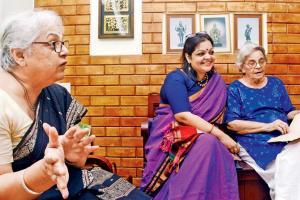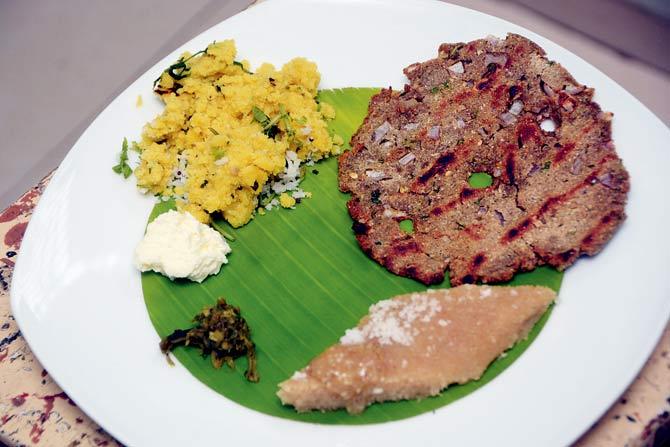Through a recipe book she dedicates to her grandmother, Saee Koranne-Khandekar invites readers to a pangat that celebrates food and folklore from Marathi kitchens

Saee Koranne-Khandekar flanked by her mother Sumati Koranne and grandmother Usha Kulkarni at their Kopar Khairane home. Pics/ Sneha Kharabe
At age three, chef and cookbook writer Saee Koranne-Khandekar remembers standing in the balcony of her grandmother's south Bombay home, waiting for the aroma of roasting suji. "Aai would make me identify the exact roasting point when she was making upma or sheera. It honed my sensory abilities because mind you, from the balcony at Napean Sea Road, you only smell the salt and stench of the sea more than anything else."
It is memories and recipes from aai's kitchen that find their way to Pangat—A Feast; Food and Lore from Marathi Kitchens (Hachette), her third book. Pangat refers to community eating. She said the title answers this writer's first question to her: What is Marathi cuisine? It traces Maharashtrian food across the regions—Khandesh, Vidarbha, Konkan, Marathwada and Desh—and then through sub-communities. In the recipe section, Saee makes room for andaaza and intuitive cooking. "I may recommend a teaspoon of tamarind extract but if the extract you are using is thicker, discretion has to come in," says Saee, who started Angat Pangat, a Facebook group dedicated to Maharashtrian cuisine in 2015. In 2017 she launched an online magazine called Diwali Pangat, which has seen two editions so far.
ADVERTISEMENT
Interestingly, the book goes beyond food and covers utensils and cooking methods too. "In Maharashtrian kitchens, we have so many types of steamers and patilas. A conical shaped tapeluh is used to make rice. The shape holds the steam so that the rice doesn't lose its aroma. A gundi is used for thin soups (saar) to be cooked on a rolling boil and simmered longer. We use techniques like paanyacha taat (condensation)—putting a thali filled with water on a vessel to cook the food. I wanted to write a book that placed food in its socio-cultural context."
 Saee Koranne-Khandekar makes crispy thali peeth
Saee Koranne-Khandekar makes crispy thali peeth
That she comes from a family that loves to eat made putting the book together easier. "When we wake up, we are thinking, 'What's for breakfast?' While eating it, we are plotting what to do for lunch!" Her mother, Sumati Koranne, 64 and maternal grandmother Aai Usha Kulkarni, 90, join in for a conversation.
Grandmother's tales: Having grown up in Hubli in a family of 30 people, Usha remembers her father dissecting dishes. "I didn't cook much but we ate and discussed everything. My father would point out, 'Mithaachya haataane gool ghaatlaas ka? (Did you pick jaggery without washing the hands after using salt?)'"
Soon after college in Pune, Usha Gore married into a nuclear Kulkarni family. They travelled through Gujarat, Nagpur and Nasik, thanks to her husband's IAS post. Aai laughs, "When I got married, I could make dal rice in the cooker. The rest, I learnt through trial and error. I would recall the taste of my mother's cooking and work at replicating it. My mother would write me letters, sharing recipes," she says, adding that her biggest dilemma was to cook for two. I had grown up in a household of 30. No matter how much I tried, there would always be excess."
Making Marathi cool: "Aai inculcated in me a pride for Maharashtrian cuisine via a vocabulary that was easy for a child to appreciate. She would make bhakris and stuff them with a filling—some leftover bhaaji or a chutney mixed with fresh homemade butter. How different is that from a pita, she would ask? When a cuisine is glorified, there is an aspirational value attached to it." Aai always proudly served Marathi fare even to her friends when they dropped in from college, remembers Saee, who did a pop-up at Pot Pourri in Chembur and Vashi in an attempt challenge culinary class vocabulary by serving bar food on the lines of tostada thalipeeth and sabudana poppers.

The fraying pages of aai's recipe book holds details of measures of ingredients for various pickles
Sumati, confesses she has never been a big cook. "I haven't made a single puran poli in my life. I am happy to Saee taking this up as a profession and passion. We are so proud of her." Saee quickly adds, "They are both modest. If she could, Amma would dabble with paint all day and Aai would read. But I can never achieve the taste of chutneys and pickles close to what they make even if I tried."
This household makes its own goda masala among other things, and their recipes don't use dagad phool (mountain moss) because a certain family member was once prone to acidity. "In those days, when shahjeera was a rarity, we would tweak recipes to avoid using it. One must learn to cook with available ingredients," says aai.
We ask about the Dumpokta, a recipe with a name that has a Mughal ring to it. It is a spicy vegetarian curry with small potatoes, brinjals and onions. While it is not a traditional Maharashtrian dish, it is a house specialty. "My great grandfather's mama was posted in a royal family. When he tasted this curry with saffron and spice yogurt, he created a vegetarian version rich with ghee and no water. He added coconut to give it some body."
 Saee’s morning breakfast of thali peeth, homemade butter, Khandeshi thecha, vaatli dal and khandvi
Saee’s morning breakfast of thali peeth, homemade butter, Khandeshi thecha, vaatli dal and khandvi
What's for breakfast? The conversation moves to the table where breakfast has been laid out. Hand flattened kadak thali peeth with spring onion thecha that cook, Meera bai, has pounded. "This is a typical rendition of thecha from her village in Jalgaon, Khandesh," says Saee. The menu for the morning is vaatli dal and suji khandvi, a sweet dish made with semolina, smothered with a dollop of home-made butter.
Aai points out, "Cooking at home is like pursuing a career. You have to give it your all. If you do the same thing every day, you will improve." Almost like running a restaurant we tell her. She nods, slipping another Thalipeeth into our plate.
Khandvi (rice and jaggery squares)
Serves 4
- 1 cup rice semolina (idli rava)
- 2 ½ cups water
- 2 tbsp ghee + a little extra for greasing
- ½ cup jaggery or as per taste
- ½ cup fresh coconut, scraped
- ½ tsp green gram cardamom powder
Grease a tray or thali with a few drops of ghee and set it aside.
Put the jaggery and water in a saucepan and bring to gentle boil until the jaggery melts. Keep warm until required.
Heat the ghee in a kadhai. Add the semolina and roast over a low flame until it is fragrant and turns slightly pinkish. Add almost all the fresh coconut, reserving some for garnish, and pour in the jaggery water. Mix well to ensure there are no lumps. Cover and cook until the semolina is cooked through and no opague centre is seen, (about five minutes).
Add the cardamom powder, mix well and turn off the heat. At this point, the mixture should come together in a ball. If it is too dry, sprinkle a little water and mix again.
Put the mixture into the greased tray and spread to an even thickness (about half an inch) using a spatula or the back of a bowl. Sprinkle the reserved coconut on top and press it down lightly. Cool for 12 minutes. Cut into squares or diamonds and serve.
Catch up on all the latest Mumbai news, crime news, current affairs, and also a complete guide on Mumbai from food to things to do and events across the city here. Also download the new mid-day Android and iOS apps to get latest updates
 Subscribe today by clicking the link and stay updated with the latest news!" Click here!
Subscribe today by clicking the link and stay updated with the latest news!" Click here!







